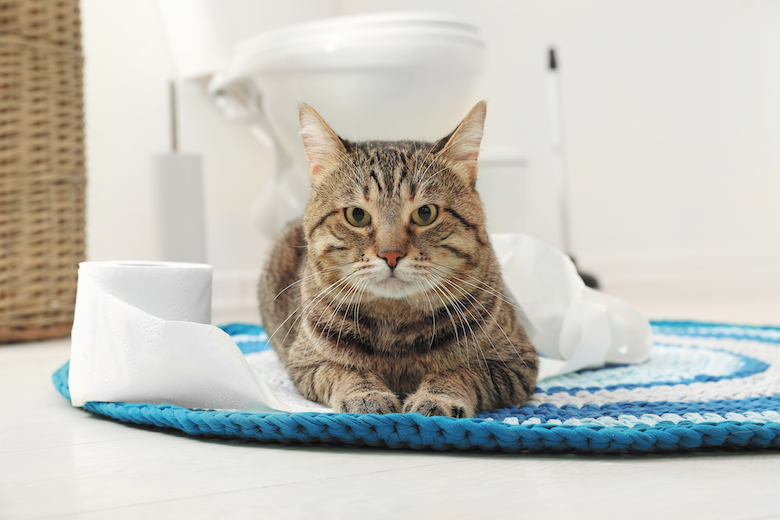Welcome to a scary, often puzzling feline “u-niverse.” That “u” includes urinary stones and urinary tract infections. Far too many cats experience a variety of urinary issues that can be painful and, in some instances, life-threatening. Fortunately, effective weapons to tame or combat a host of urinary issues can be found in your cat’s food bowl.
Issues impacting your cat’s urethra or bladder can be among many conditions that fall under an umbrella term known as Feline Lower Urinary Tract Disease (FLUTD). In addition to bacterial or viral infections, they include formation of stones in the bladder or urethra or urinary blockages, more common in male cats than females because the male urethra is longer and narrower. The urethra is that channel that ushers urine out of the bladder.
Related: 8 Things You Should Know About Feline Lower Urinary Tract Disease
But the cause of a urinary issue may never be identified, so your veterinarian will use the term feline idiopathic cystitis (FIC). Idiopathic means unknown cause, as this disease is not fully understood and may affect body systems beyond the urinary system.
Cat urinary issue warning signs
Plumbing problems in cats can quickly surface or develop over time. Consult your veterinarian promptly if your cat displays any of these warning signs:
- Straining to urinate
- Urinating more frequently than normal
- Crying out in pain when urinating
- Evidence of blood in the urine
- Excessively licking the genital area
- Dribbling urine
- Bypassing the litter box to urinate elsewhere
- Urine gives off a strong ammonia odor
Diets prescribed by a vet
Expect your veterinarian to recommend switching your cat to a therapeutic diet for urinary issues. Some of the popular therapeutic diets for urinary care include products by Blue Buffalo, Royal Canin, Hill’s Prescription Diet and Purina Pro Plan. Dry and canned food options are available.
Each brand offers details on the benefits of their diets and toll-free customer service phone numbers. Depending on the brand, these therapeutic foods are grain-free, low in magnesium content, contain specific minerals to support urinary health, are formulated to promote healthy urine volume and acidity and are enriched with antioxidants and omega-3 fatty acids.
Stick with the therapeutic diet prescribed by your veterinarian. Giving food scraps or cat treats may cancel out the health benefits from ingredients in the special diet food.
Diets from your local store
Commercial diets are also available that contain ingredients designed to maintain a healthy urinary system in cats. Many are high in proteins and low in carbohydrates. The Wysong Uretic Dry Cat Food contains high levels of fresh and frozen meats as well as omega-3s, probiotics and methionine to help keep a cat’s urinary tract healthy.
Dr. Marty Goldstein, a holistic veterinarian and acupuncturist based in South Salem, New York, launched his food brand after his beloved cat Zots died from a urinary blockage. “When this happened with Zots, two and two just came together on what could contribute to this congestive debris that forms in the urinary tract related to improper or not biologically appropriate diet,” he says. “Cats deserve biologically appropriate diets that support metabolic and immunologic function.”
Dr. Marty’s Premium Freeze-Dried Cat Food is a freeze-dried, raw, nutritionally dense formula made with turkey, ranch-raised beef, duck and salmon plus sweet potatoes, carrots, apples, blueberries and cranberries. Dr. Goldstein says, “A predominately whole meat should be the first and primary ingredient and if this is some form of raw, even better.”
More water and less stress
These two tactics reduce your cat’s risk for urinary issues: hydration and less stress. Dr. Tony Buffington, emeritus professor of Veterinary Clinical Sciences at The Ohio State University Veterinary Medical Center says, “Put the water bowl in a safe place so the cat will not feel frightened when he needs to drink. Don’t place the cat’s food or water bowls, for example, next to the dishwasher. If it comes on suddenly while the cat is eating or drinking, the sound can be threatening and cause stress.”
Increase your cat’s water intake by adding flavor to his water bowl, such as tuna or clam juice or sodium-free chicken or beef broth. Or try a cat water fountain placed in his favorite hangout areas in the house.
Make mealtime inviting and safe. “Stress does play a huge role in the incidents of urinary problems in cats,” Dr. Goldstein says. Stress can occur in the form of food resource guarding or dogs in the family preventing cats from accessing the water bowl.
“Avoid having multiple cats in the home eating from one large dish,” Dr. Buffington adds. “Keep the environment safe for all by feeding the cats in separate bowls spaced out. Consider a water bowl on a sturdy elevated surface out of reach of the dogs. Finally, consider serving a meal in a food puzzle to activate your cat’s inner hunter.”
Top photograph: belchonock | Getty Images
Read Next: How to Feed Cats: Are We Doing It Wrong?
